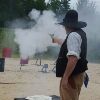brutus51
Member
- Joined
- Apr 7, 2013
- Messages
- 1,367
Just out of curiosity I checked the gap of my revolvers. Always set my Dan Wesson at .004 thousands which works great, but my fixed barrel guns are as follows:
1978 Colt Python (My most accurate revolver) .006
Colt King Cobra Target .004
2022 Colt Python .005
Colt Cobra 38 Special .005
Colt Agent .003
Smith & Wesson 629 .004
Smith & Wesson 625 .45 Colt .005
Ruger single six 22lr. .004
Ruger single six 22 Mag. .004
Oddly enough the Colt Agent is an Aluminum frame parkerized tackle box gun.
Just found this interesting, kinda thing us old retirees have time for.
1978 Colt Python (My most accurate revolver) .006
Colt King Cobra Target .004
2022 Colt Python .005
Colt Cobra 38 Special .005
Colt Agent .003
Smith & Wesson 629 .004
Smith & Wesson 625 .45 Colt .005
Ruger single six 22lr. .004
Ruger single six 22 Mag. .004
Oddly enough the Colt Agent is an Aluminum frame parkerized tackle box gun.
Just found this interesting, kinda thing us old retirees have time for.






